2020 Hyundai Tucson towing
[x] Cancel search: towingPage 16 of 637
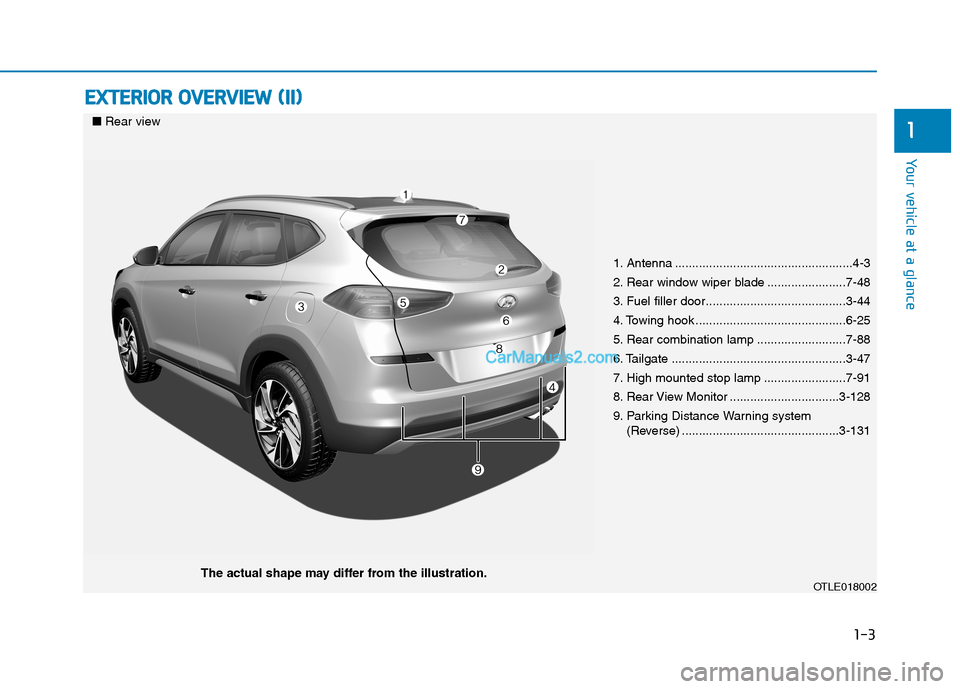
1-3
Your vehicle at a glance
E EX
XT
TE
ER
RI
IO
OR
R
O
OV
VE
ER
RV
VI
IE
EW
W
(
(I
II
I)
)
1
1. Antenna ....................................................4-3
2. Rear window wiper blade .......................7-48
3. Fuel filler door.........................................3-44
4. Towing hook ............................................6-25
5. Rear combination lamp ..........................7-88
6. Tailgate ...................................................3-47
7. High mounted stop lamp ........................7-91
8. Rear View Monitor ................................3-128
9. Parking Distance Warning system
(Reverse) ..............................................3-131
OTLE018002
■Rear view
The actual shape may differ from the illustration.
Page 52 of 637

2-31
Safety system of your vehicle
2
4. Insert the tongue plate (A) into the
hole on the belt assembly cover.Stowing the rear seat belt
The rear seat belt buckles can be
stowed in the pocket between the
rear seatback and cushion when not
in use.
Pre-tensioner seat belt
(Driver and front passenger)
Your vehicle is equipped with driver's
and front passenger's Pre-tensioner
Seat Belts (Retractor Pre-tensioner
and Emergency Fastening Device
(EFD)). The purpose of the pre-ten-
sioner is to make sure the seat belt
fits tightly against the occupant's
body in certain frontal collisions. The
pre-tensioner seat belts may be acti-
vated in crashes where the frontal
collision is severe enough, together
with the air bags.
OTLE035078OLMB033037
OTL035053R
Page 319 of 637
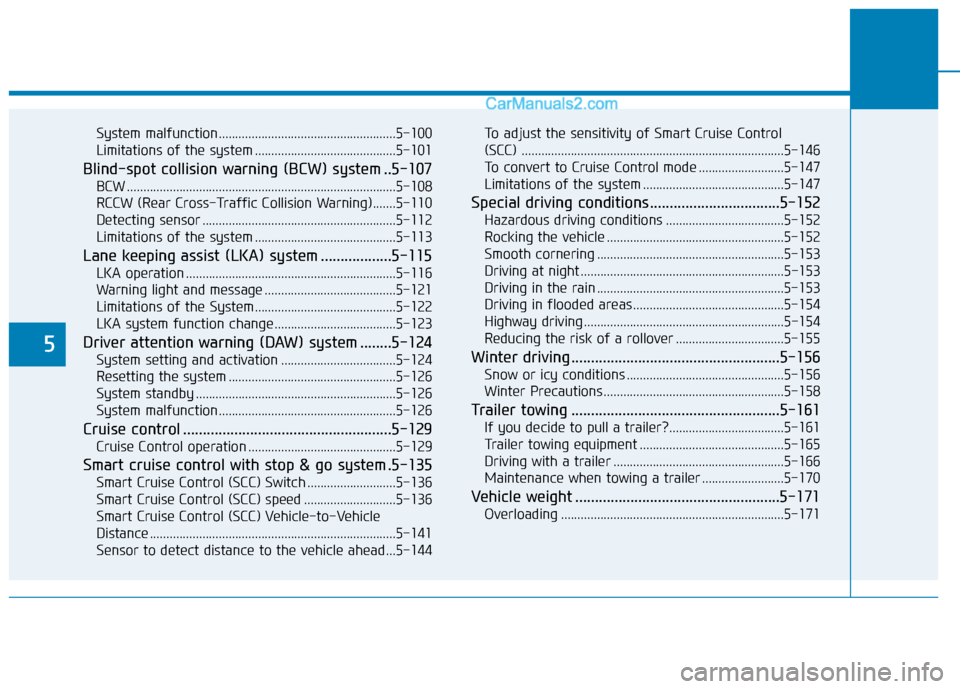
5
System malfunction......................................................5-100
Limitations of the system ...........................................5-101
Blind-spot collision warning (BCW) system ..5-107
BCW ..................................................................................5-108
RCCW (Rear Cross-Traffic Collision Warning).......5-110
Detecting sensor ...........................................................5-112
Limitations of the system ...........................................5-113
Lane keeping assist (LKA) system ..................5-115
LKA operation ................................................................5-116
Warning light and message ........................................5-121
Limitations of the System...........................................5-122
LKA system function change .....................................5-123
Driver attention warning (DAW) system ........5-124
System setting and activation ...................................5-124
Resetting the system ...................................................5-126
System standby .............................................................5-126
System malfunction......................................................5-126
Cruise control .....................................................5-129
Cruise Control operation .............................................5-129
Smart cruise control with stop & go system .5-135
Smart Cruise Control (SCC) Switch ...........................5-136
Smart Cruise Control (SCC) speed ............................5-136
Smart Cruise Control (SCC) Vehicle-to-Vehicle
Distance ...........................................................................5-141
Sensor to detect distance to the vehicle ahead ...5-144To adjust the sensitivity of Smart Cruise Control
(SCC) ................................................................................5-146
To convert to Cruise Control mode ..........................5-147
Limitations of the system ...........................................5-147
Special driving conditions .................................5-152
Hazardous driving conditions ....................................5-152
Rocking the vehicle ......................................................5-152
Smooth cornering .........................................................5-153
Driving at night ..............................................................5-153
Driving in the rain .........................................................5-153
Driving in flooded areas..............................................5-154
Highway driving .............................................................5-154
Reducing the risk of a rollover .................................5-155
Winter driving .....................................................5-156
Snow or icy conditions ................................................5-156
Winter Precautions .......................................................5-158
Trailer towing .....................................................5-161
If you decide to pull a trailer?...................................5-161
Trailer towing equipment ............................................5-165
Driving with a trailer ....................................................5-166
Maintenance when towing a trailer .........................5-170
Vehicle weight ....................................................5-171
Overloading ....................................................................5-171
Page 365 of 637

5-48
Driving your vehicle
In an Automatic transmission/dual
clutch transmission vehicle
1. Start the engine.
2. Fasten the driver's seat belt.
3. Close the driver's door, engine
bonnet and tailgate.
4. Depress the accelerator pedal
whilst the shift lever is in R
(Rear), D (Drive) or Sports mode.
Make sure the Parking Brake
Warning light goes off.
Information
• For your safety, you can engage the
EPB even though the Engine
Stop/Start button is in the OFF posi-
tion, but you cannot release it.
• For your safety, depress the brake
pedal and release the parking brake
manually with the EPB switch when
you drive downhill or when revers-
ing the vehicle.
Information - Manual trans-
mission
A vehicle towing a trailer on a hill or
on an incline may roll slightly rear-
wards when starting the vehicle.
To prevent the situation follow the
below instructions.
1. Depress the clutch pedal and select
a gear.
2. Keep pulling up the EPB switch.
3. Depress the accelerator pedal and
slowly release the clutch pedal.
4. If the vehicle starts off with enough
driving power release the EPB
switch.
Do not follow the above procedure
when driving on a flat level ground.
The vehicle may suddenly move for-
ward. If the parking brake warning
light is still on even though the
EPB has been released, we rec-
ommend that the system be
checked by an authorised
HYUNDAI dealer.
Do not drive your vehicle with
the EPB applied. It may cause
excessive brake pad and brake
rotor wear.
When the EPB (Electronic Parking
Brake) does not release:
We recommend that you contact an
authorised HYUNDAI dealer and
load the vehicle on a flatbed tow
truck to have the system checked.
NOTICEi
i
Page 384 of 637
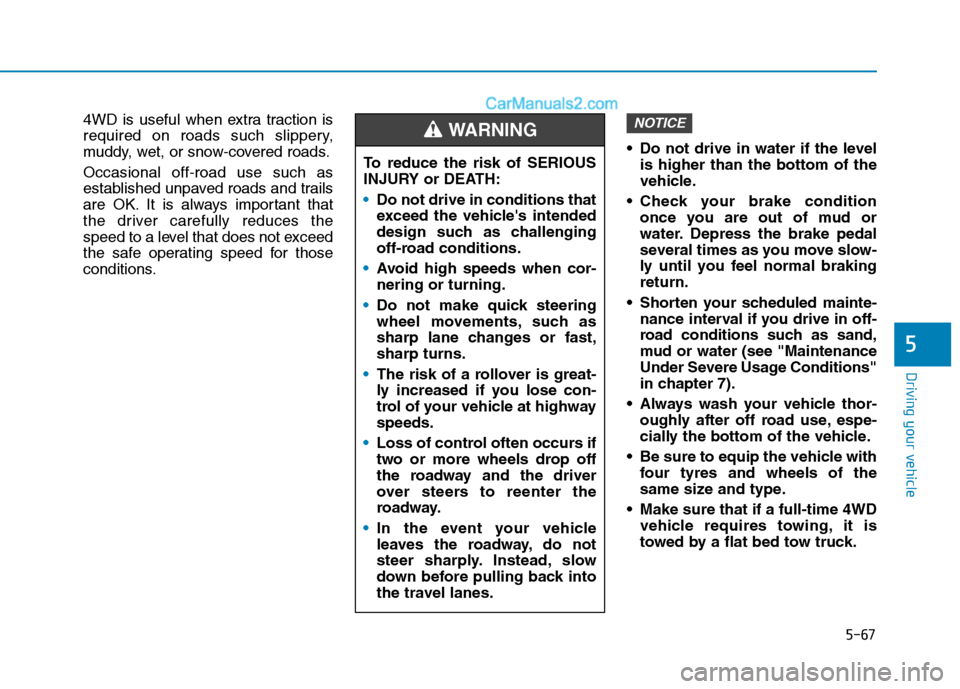
5-67
Driving your vehicle
5
4WD is useful when extra traction is
required on roads such slippery,
muddy, wet, or snow-covered roads.
Occasional off-road use such as
established unpaved roads and trails
are OK. It is always important that
the driver carefully reduces the
speed to a level that does not exceed
the safe operating speed for those
conditions. Do not drive in water if the level
is higher than the bottom of the
vehicle.
Check your brake condition
once you are out of mud or
water. Depress the brake pedal
several times as you move slow-
ly until you feel normal braking
return.
Shorten your scheduled mainte-
nance interval if you drive in off-
road conditions such as sand,
mud or water (see "Maintenance
Under Severe Usage Conditions"
in chapter 7).
Always wash your vehicle thor-
oughly after off road use, espe-
cially the bottom of the vehicle.
Be sure to equip the vehicle with
four tyres and wheels of the
same size and type.
Make sure that if a full-time 4WD
vehicle requires towing, it is
towed by a flat bed tow truck.NOTICE
To reduce the risk of SERIOUS
INJURY or DEATH:
Do not drive in conditions that
exceed the vehicle's intended
design such as challenging
off-road conditions.
Avoid high speeds when cor-
nering or turning.
Do not make quick steering
wheel movements, such as
sharp lane changes or fast,
sharp turns.
The risk of a rollover is great-
ly increased if you lose con-
trol of your vehicle at highway
speeds.
Loss of control often occurs if
two or more wheels drop off
the roadway and the driver
over steers to reenter the
roadway.
In the event your vehicle
leaves the roadway, do not
steer sharply. Instead, slow
down before pulling back into
the travel lanes.
WARNING
Page 389 of 637
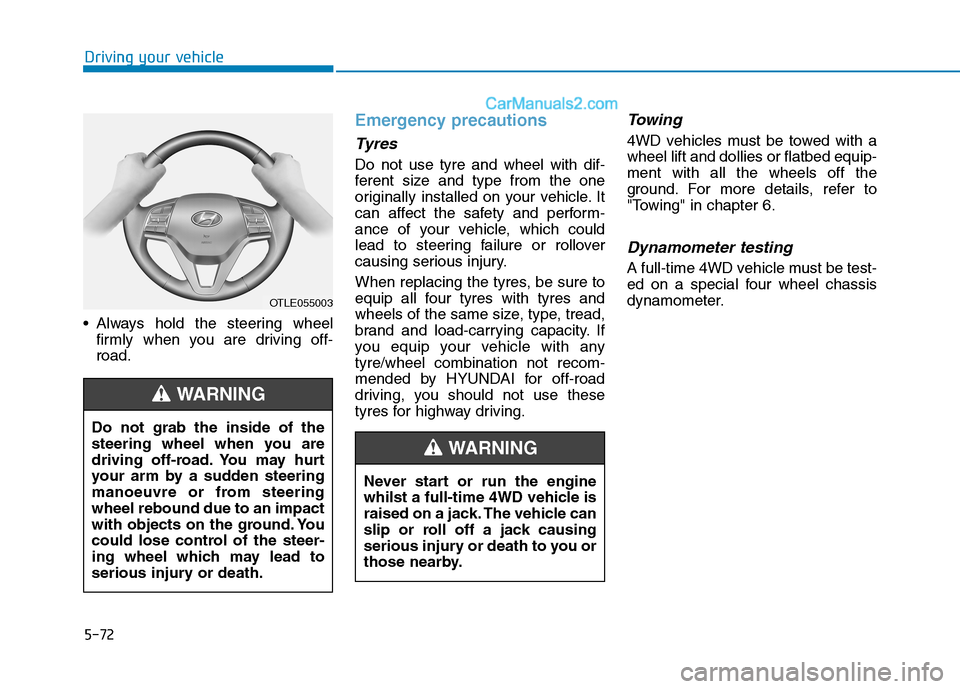
5-72
Driving your vehicle
Always hold the steering wheel
firmly when you are driving off-
road.
Emergency precautions
Tyres
Do not use tyre and wheel with dif-
ferent size and type from the one
originally installed on your vehicle. It
can affect the safety and perform-
ance of your vehicle, which could
lead to steering failure or rollover
causing serious injury.
When replacing the tyres, be sure to
equip all four tyres with tyres and
wheels of the same size, type, tread,
brand and load-carrying capacity. If
you equip your vehicle with any
tyre/wheel combination not recom-
mended by HYUNDAI for off-road
driving, you should not use these
tyres for highway driving.
Towing
4WD vehicles must be towed with a
wheel lift and dollies or flatbed equip-
ment with all the wheels off the
ground. For more details, refer to
"Towing" in chapter 6.
Dynamometer testing
A full-time 4WD vehicle must be test-
ed on a special four wheel chassis
dynamometer.
OTLE055003
Do not grab the inside of the
steering wheel when you are
driving off-road. You may hurt
your arm by a sudden steering
manoeuvre or from steering
wheel rebound due to an impact
with objects on the ground. You
could lose control of the steer-
ing wheel which may lead to
serious injury or death.
WARNING
Never start or run the engine
whilst a full-time 4WD vehicle is
raised on a jack. The vehicle can
slip or roll off a jack causing
serious injury or death to you or
those nearby.
WARNING
Page 408 of 637
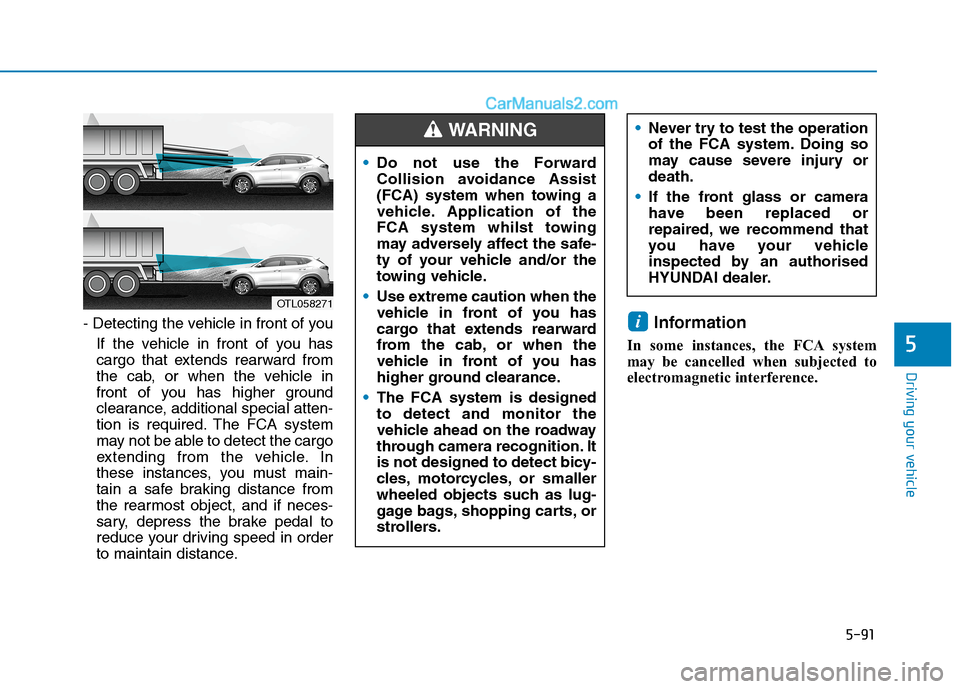
5-91
Driving your vehicle
- Detecting the vehicle in front of you
If the vehicle in front of you has
cargo that extends rearward from
the cab, or when the vehicle in
front of you has higher ground
clearance, additional special atten-
tion is required. The FCA system
may not be able to detect the cargo
extending from the vehicle. In
these instances, you must main-
tain a safe braking distance from
the rearmost object, and if neces-
sary, depress the brake pedal to
reduce your driving speed in order
to maintain distance.Information
In some instances, the FCA system
may be cancelled when subjected to
electromagnetic interference.
i
5
OTL058271
Do not use the Forward
Collision avoidance Assist
(FCA) system when towing a
vehicle. Application of the
FCA system whilst towing
may adversely affect the safe-
ty of your vehicle and/or the
towing vehicle.
Use extreme caution when the
vehicle in front of you has
cargo that extends rearward
from the cab, or when the
vehicle in front of you has
higher ground clearance.
The FCA system is designed
to detect and monitor the
vehicle ahead on the roadway
through camera recognition. It
is not designed to detect bicy-
cles, motorcycles, or smaller
wheeled objects such as lug-
gage bags, shopping carts, or
strollers.
WARNING Never try to test the operation
of the FCA system. Doing so
may cause severe injury or
death.
If the front glass or camera
have been replaced or
repaired, we recommend that
you have your vehicle
inspected by an authorised
HYUNDAI dealer.
Page 423 of 637

5-106
The pedestrian is small
The pedestrian has impaired
mobility
The sensor recognition is limited
The radar sensor or camera is
blocked with a foreign object or
debris
Inclement weather such as heavy
rain or snow obscures the field of
view of the radar sensor or camera
When light coming from a street
light or an oncoming vehicle is
reflected on a wet road surface
such as a puddle in the road
The field of view in front is
obstructed by sun glare
The windscreen glass is fogged
up; a clear view of the road is
obstructed
The adverse road conditions cause
excessive vehicle vibrations whilst
driving
When the pedestrian suddenly
interrupts in front of the vehicle
Information
In some instances, the FCA system
may be cancelled when subjected to
electromagnetic interference.
i
Driving your vehicle
Never try to test the operation
of the FCA system. Doing so
may cause severe injury or
death.
If the front bumper, front
glass, radar or camera have
been replaced or repaired, we
recommend that you have
your vehicle inspected by an
authorised HYUNDAI dealer.
Do not use the Forward
Collision avoidance Assist
(FCA) system when towing a
vehicle. Application of the
FCA system whilst towing
may adversely affect the safe-
ty of your vehicle and/or the
towing vehicle.
Use extreme caution when the
vehicle in front of you has
cargo that extends rearward
from the cab, or when the
vehicle in front of you has
higher ground clearance.
The FCA system is designed
to detect and monitor the
vehicle ahead or detect a
pedestrian on the roadway
through radar signals and
camera recognition. It is not
designed to detect bicycles,
motorcycles, or smaller
wheeled objects such as lug-
gage bags, shopping carts, or
strollers.
WARNING